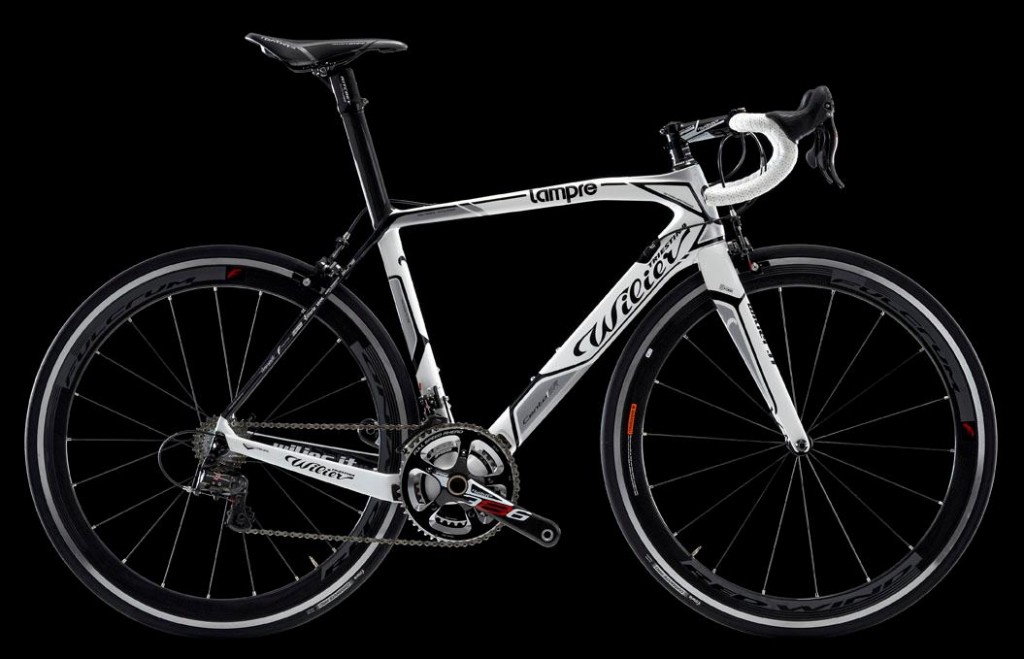
Wilier Cento SR reimagined Cento1 SR follows an increasingly common trend among top-end race bikes: convergence. In the past few years, many companies had two high-end race bikes
: one as light and stiff as possible, the other designed in a wind tunnel to ensure an aerodynamic advantage.
While that trend remains, companies are beginning to blend aerodynamic characteristics into their lightest frames. Scott may have been the first brand when it released the Foil last year. Now, two other bikes are showing similar characteristics: Trek’s just-released Madone 7 and Wilier-Triestina’s new Wilier Cento1 SR.
Sneaky Aerodynamics
Like the Scott Foil and Trek Madone 7, Wilier Cento1 SR uses aero-shaped tubes that have had their tails truncated—sometimes called Kamm Tails—on the fork and seat tube/mast. Theoretically, the careful shaping has nearly the same aerodynamic characteristics as a wing-shaped airfoil in a headwind, even though the tail itself has been cut off. The benefit of using a Kamm Tail tube is that designers wind up with a more traditional shape, which is stiffer, lighter, and can be made more compliant than broader aero shapes.
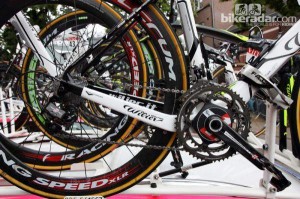 All New Frame
All New Frame
Tubes shapes are just one element on a totally redesigned bike, however. Gone are the organic, rounded lines of the previous Cento1. In their place are bigger tubes and many more squared edges, all enhanced by a paint scheme that evokes Tron. The company also used more 60 Ton carbon than in the Cento1 Superleggera. The material, combined with the bigger tubes, improves stiffness.
Wilier Cento 1 SR also built more stiffness into the fork and bottom bracket. The fork uses a new tapered steerer fork from 1-1/8” down to 1-1/4″ (the old Cento1 used a straight 1-1/8″ steerer), with a crown that flows smoothly into the down tube. At the lower end of the frame is a new BB386EVO bottom bracket shell. The previous Cento1 also used a press-fit system with different cups for the various crank axles. BB386EVO, essentially a wider BB30 shell which was a co-developed by BH, Wilier, and FSA, is even bigger and optimized for a 386EVO crank with 30mm axle. However, with the correct conversion kit, the frame is compatible with almost all cranks, aside from BB30 and square-taper models.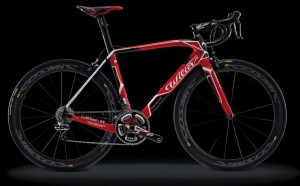
One of the primary reasons to use the BB386EVO is to provide lots of area to attach big, stiff tubes. The Cento1 SR’s non-drive chainstay is about 65mm high and 25mm wide where it joins the BB; the downtube about 80mm across.
Wilier also adjusted the geometry. Head tube lengths are mostly shorter in every size, except small, which is a bit longer to make the per-size jumps more uniform than they were in 2012. The medium size receives the biggest geometry change: the seat and head tube angles are both a half-degree slacker, making the top tube a bit longer.
Down tube barrel adjusters on the top of the tube allow for easier shifting tweaks with mechanical drivetrains.
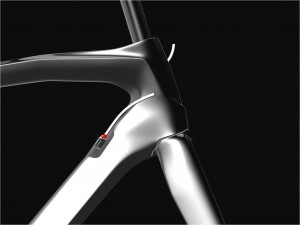 One Frame for Two Shifting Systems
One Frame for Two Shifting Systems
Joining yet another increasingly common trend, the Cento1 SR frame has internal routing for either electronic wires or mechanical cables. For mechanical shifting, the company built barrel adjusters into the access panel on the top of the down tube where they’re easy to thumb while riding—just be careful your fingers don’t slip into the tire. The bottom bracket cable guide has a large radius to reduce friction with mechanical shifting.
Shift cables and wiring is routed through the rear dropouts and integrated derailleur hanger.
With electronic shifting, you use a different down tube guide, and remove the barrel adjusters. The bottom bracket cable guide is replaced with a blank access panel for fishing the wiring through the frame, and the battery mounts under the downtube.
Instead of a replaceable derailleur hanger, Wilier incorporates a replaceable dropout, which they claim is a stiffer, and makes for more precise shifting. The rear shifting cable routes though the dropout, and there is a specific part for both mechanical and electronic systems.
Weight and Price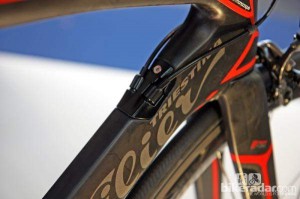
Weight for a medium frame, with seatmast, is claimed to be 995 grams; 360 grams for the fork. This makes the new bike 55 grams lighter than the standard Cento1, but 70 grams heavier than the Cento1 SuperLeggera. Wilier says it’s a fair tradeoff for the SR’s stiffer frame, better handling and improved overall ride.
While the amazing Zero.7 remains Wilier’s top model, the Cento1 SR is the bike’s workhorse race machine. The Cento1 SR frameset (frame, fork, Ritchey seatmast topper, headset) costs $3,999. For the U.S., there is one complete bike option: a $5,599 model with Campagnolo Chorus 11, customized FSA stem, bar, and BB386EVO crank, Selle Italia SLR saddle, and Fulcrum Racing 4 wheels. Wilier’s U.S. representative says other complete models may be available in the near future. Two colors: black with red (shown) or red with black. Our test bike—size medium with the Chorus package—weighted 15.5 pounds out of the box.
The flat backside of the seatmast displays the frame’s Kamm Tail shaping.
First Ride Impressions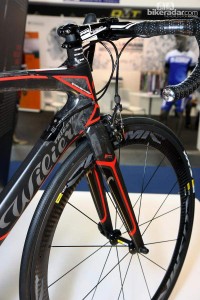
Like most modern carbon race bikes, it has an impressive combination of low weight, high frame stiffness, and responsive, balanced handling. And as far as race bikes go, the Cento1 is a reasonably smooth riding frame. It’s stiff enough to remind you that you’re on a high-performance bike, while able to communicate the road texture and feel fast. But, at the end of a long day in the saddle, you don’t feel as though you’ve been tumbled in an industrial dryer with cinder blocks.
While we say this kind of thing about a lot of high-end bikes—because it describes how many of this type of bike ride—some feel anonymous and forgettable while still doing everything well. So far, we’ve found that the Cento1 has that little bit extra, a touch more life and character, that keeps us interested and excited every time we saddle up.
We’ll have our final impressions in a test of the Cento 1 SR in the November 2012 issue of Bicycling.
Summary =
Wilier’s reimagined Cento1 SR follows an increasingly common trend among top-end race bikes: convergence. Now, two other bikes are showing similar characteristics: Trek’s just-released Madone 7 and Wilier-Triestina’s new Cento1 SR.
Like the Scott Foil and Trek Madone 7, Wilier’s Cento1 SR uses aero-shaped tubes that have had their tails truncated—sometimes called Kamm Tails—on the fork and seat tube/mast. All New Frame
Tubes shapes are just one element on a totally redesigned bike, however. The material, combined with the bigger tubes, improves stiffness.
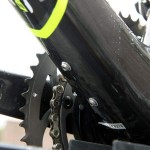 Wilier also built more stiffness into the fork and bottom bracket. Down tube barrel adjusters on the top of the tube allow for easier shifting tweaks with mechanical drivetrains.
Wilier also built more stiffness into the fork and bottom bracket. Down tube barrel adjusters on the top of the tube allow for easier shifting tweaks with mechanical drivetrains.
One Frame for Two Shifting Systems
Joining yet another increasingly common trend, the Cento1 SR frame has internal routing for either electronic wires or mechanical cables. This makes the new bike 55 grams lighter than the standard Cento1, but 70 grams heavier than the Cento1 SuperLeggera. Wilier says it’s a fair tradeoff for the SR’s stiffer frame, better handling and improved overall ride.
While the amazing Zero.7 remains Wilier’s top model, the Cento1 SR is the bike’s workhorse race machine. The Cento1 SR frameset (frame, fork, Ritchey seatmast topper, headset) costs $3,999. The flat backside of the seatmast displays the frame’s Kamm Tail shaping.
First Ride Impressions
Like most modern carbon race bikes, it has an impressive combination of low weight, high frame stiffness, and responsive, balanced handling. And as far as race bikes go, the Cento1 is a reasonably smooth riding frame.
Source = bicycling

